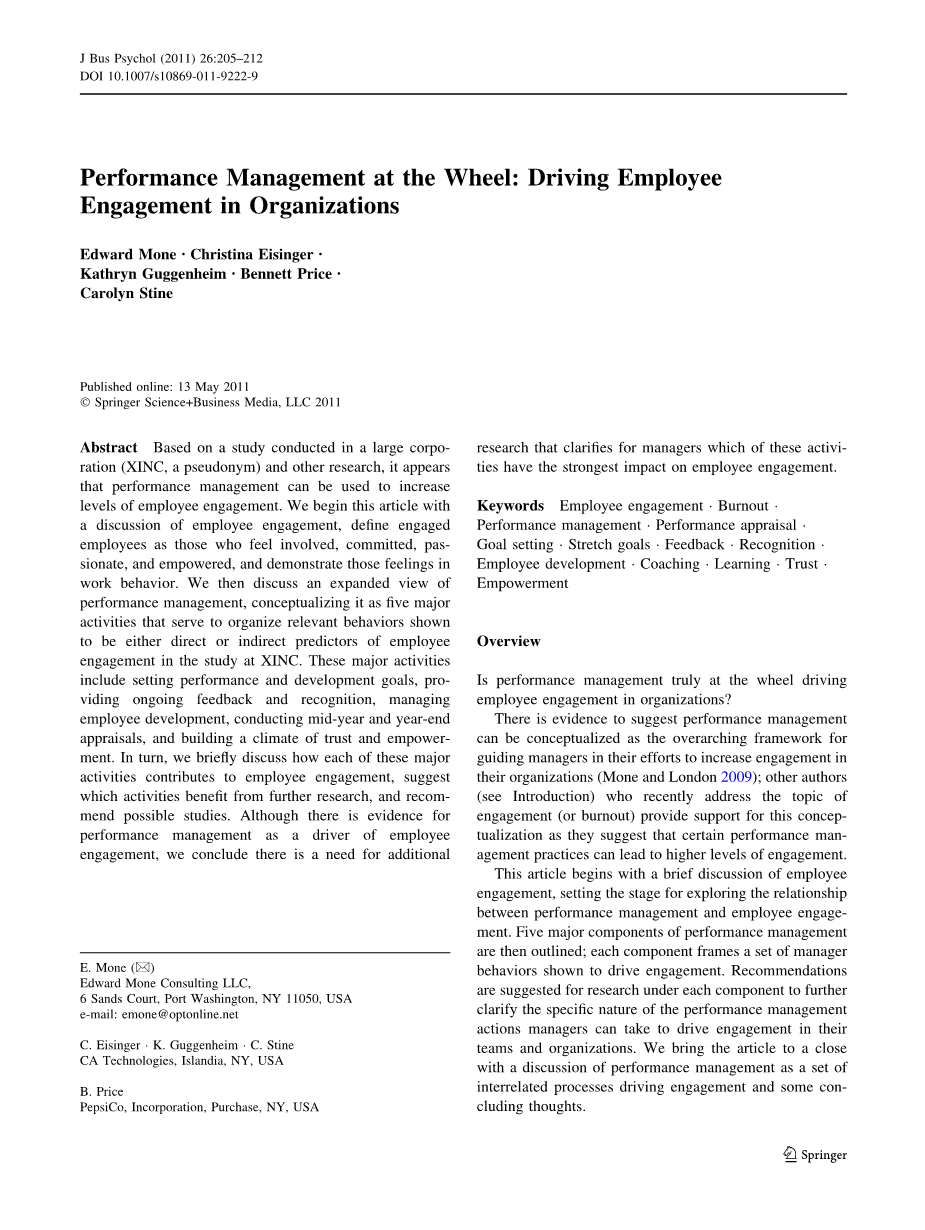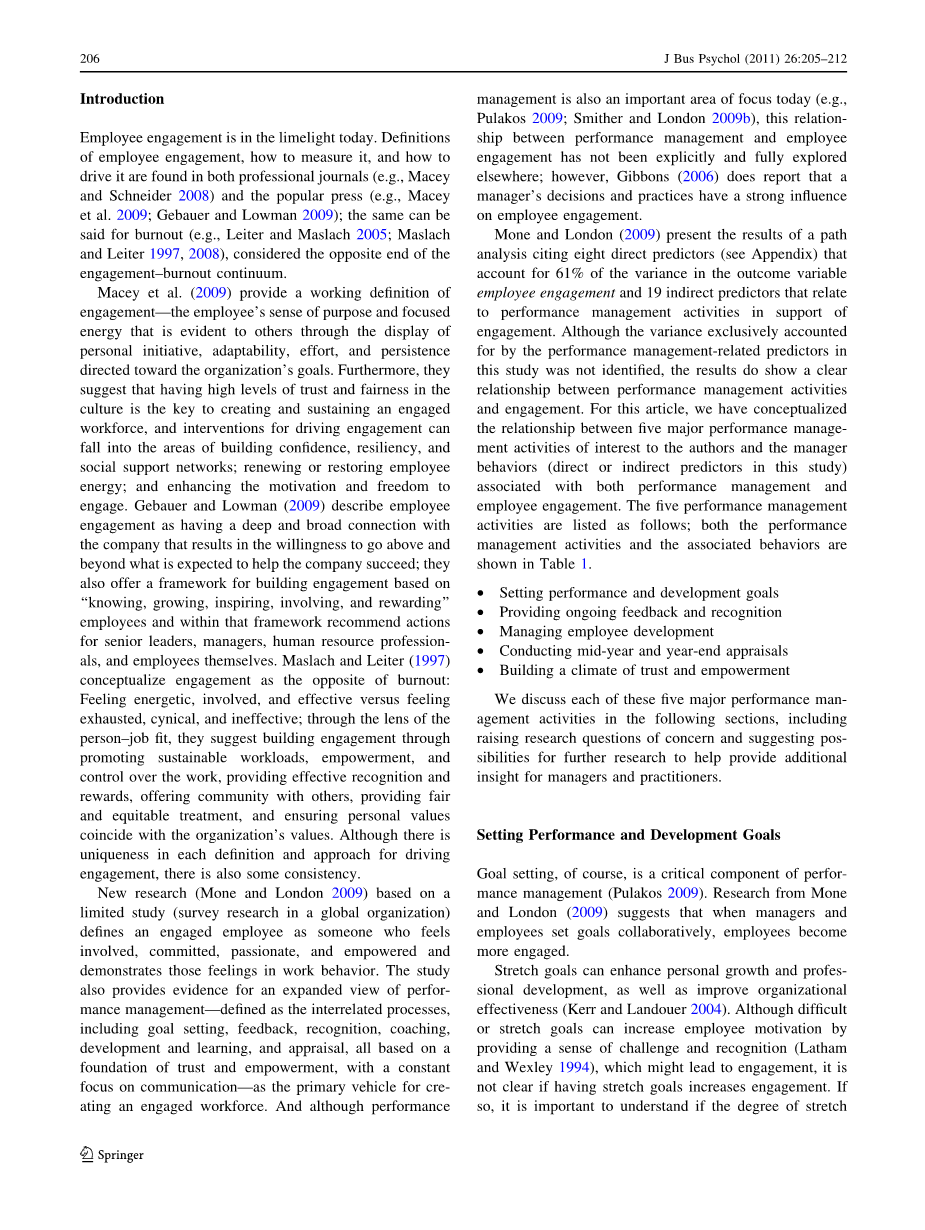

英语原文共 9 页,剩余内容已隐藏,支付完成后下载完整资料
Overview
Is performance management truly at the wheel driving employee engagement in organization?
There is evidence to suggest performance management can be conceptualized as the overarching framework for guiding managers in their efforts to increase engagement in their organizations; other authors (see Introduction) who recently address the topic of engagement (or burnout) provide support for this conceptualization as they suggest that certain performance management practices can lead to higher levels of engagement.
This article begins with a brief discussion of employee engagement, setting the stage for exploring the relationship between performance management and employee engagement. Five major components of performance management are then outlined; each component frames a set of manager behaviors shown to drive engagement. Recommendations are suggested for research under each component to further clarify the specific nature of the performance management actions managers can take to drive engagement in their teams and organizations. We bring the article to a close with a discussion of performance management as a set of interrelated processes driving engagement and some concluding thoughts.
Introduction
Employee engagement is in the limelight today. Definitions of employee engagement, how to measure it, and how to drive it are found in both professional journals and the popular press ; the same can be said for burnout, considered the opposite end of the engagement–burnout continuum.
Macey et al. provide a working definition of engagement—the employeersquo;s sense of purpose and focused energy that is evident to others through the display of personal initiative, adaptability, effort, and persistence directed toward the organizationrsquo;s goals. Furthermore, they suggest that having high levels of trust and fairness in the culture is the key to creating and sustaining an engaged workforce, and interventions for driving engagement can fall into the areas of building confidence, resiliency, and social support networks; renewing or restoring employee energy; and enhancing the motivation and freedom to engage. Gebauer and Lowman describe employee engagement as having a deep and broad connection with the company that results in the willingness to go above and beyond what is expected to help the company succeed; they also offer a framework for building engagement based on “knowing, growing, inspiring, involving, and rewarding” employees and within that framework recommend actions for senior leaders, managers, human resource profession- als, and employees themselves. Maslach and Leiter conceptualize engagement as the opposite of burnout: Feeling energetic, involved, and effective versus feeling exhausted, cynical, and ineffective; through the lens of the person–job fit, they suggest building engagement through promoting sustainable workloads, empowerment, and control over the work, providing effective recognition and rewards, offering community with others, providing fair and equitable treatment, and ensuring personal values coincide with the organizationrsquo;s values. Although there is uniqueness in each definition and approach for driving engagement, there is also some consistency.
Mone and London present the results of a path analysis citing eight direct predictors (see Appendix) that account for 61% of the variance in the outcome variable employee engagement and 19 indirect predictors that relate to performance management activities in support of engagement. Although the variance exclusively accounted for by the performance management-related predictors in this study was not identified, the results do show a clear relationship between performance management activities and engagement. For this article, we have conceptualized the relationship between five major performance management activities of interest to the authors and the manager behaviors (direct or indirect predictors in this study) associated with both performance management and employee engagement. The five performance management activities are listed as follows; both the performance management activities and the associated behaviors are shown in Table 1.
bull; Setting performance and development goals
bull; Providing ongoing feedback and recognition
bull; Managing employee development
bull; Conducting mid-year and year-end appraisals
bull; Building a climate of trust and empowerment
We discuss each of these five major performance management activities in the following sections, including raising research questions of concern and suggesting possibilities for further research to help provide additional insight for managers and practitioners.
Setting Performance and Development Goals
Goal setting,of course,is a critical component of performance management. Research from Mone and London suggests that when managers and employees set goals collaboratively,employees become more engaged.
Stretch goals can enhance personal growth and professional development,as well as improve organizational effectiveness. Although difficult or stretch goals can increase employee motivation by providing a sense of challenge and recognition,which might lead to engagement,it is not clear if having stretch goals increases engagement. If so,it is important to understand if the degree of stretch affects the level of engagement. Managers would probably assume the greater the degree of stretch,the greater the level of engagement,but they might be wrong and their actions could lead to burnout.
Similarly,goal alignment and cascading of goals is seen as important to organizational success. Schiemann cites a number of studies showing the positive impact of alignment,including increases in employee satisfaction,but not necessarily engagement. From Mone and London,we know that communication about organization strategy and direction and helping emp
剩余内容已隐藏,支付完成后下载完整资料
资料编号:[486330],资料为PDF文档或Word文档,PDF文档可免费转换为Word


